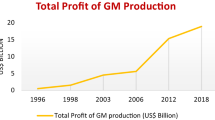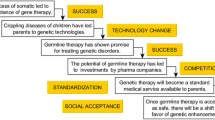Abstract
In public debate GMPs are oftenreferred to as being unnatural or a violationof nature. Some people have serious moralconcerns about departures from what is natural.Others are concerned about potential risks tothe environment arising from the combination ofhereditary material moving across naturalboundaries and the limits of scientificforesight of long-term consequences. To addresssome of these concerns we propose that anadditional element in risk assessment based onthe concept of familiarity should beintroduced. The objective is to facilitatetransparency about uncertainties inherent inthe risk assessment of the GMP. Familiarityconventionally involves data and experiencerelating to the plant species and the ecosystemin question. We would like to extend thisconcept to the molecular level of plantbreeding and suggest that GMP characteristicsshould be compared to a reference baselinedetermined by conventional breeding techniques.Three GMPs are ranked according to familiarityat the plant and ecosystem level and themolecular level. The approach may help tointegrate discussion of the scientificarguments and moral questions raised in thedebate about GMOs by providing an operationalscheme within which moral concerns are broughtwithin the framework of science-based riskassessment.
Similar content being viewed by others
REFERENCES
Anonymous, Lovforslag nr. L229, fremsat den 2. april 1986 af miljøministeren. Bemærkninger til lovforslaget (in Danish) (1986).
APHIS, Monsanto/Dekalb Petition 97-099-01p for Determination of Nonregulated Status for Transgenic Glyphosate Tolerant Corn Line GA2. Environmental Assessment and Finding of No Significant Impact. Biotechnology and Scientific Services. Animal and Plant Health Inspection Service, US Department of Agriculture, November 1997. http://www.nbiap.vt.edu/cfdocs/biopetitions1.cfm (1997).
APHIS, DuPont Petition 97-008-01p for Determination of Nonregulated Status for Transgenic High Oleic Acid Soybean Sublines G94-1, G94-19, and G-168. Environmental Assessment and Finding of No Significant Impact. Biotechnology and Scientific Services, Animal and Plant Health Inspection Service, US Department of Agriculture, May 1997. http://www.nbiap.vt.edu/cfdocs/biopetitions1.cfm (dy1997b).
Barry, G., G. Kishore, S. Padgette, M. Taylor, K. Kolacz, M. Weldon, D. Re, D. Eichholtz, K Fincher, and L. Hallas, “Inhibitors of Aminoacid Biosynthesis: strategies for Imparting Glyphosate Tolerance to Crop Plants,” in B. K. Singh, H. E. Flores, and J. S. Shannon (eds.), Biosynthesis and Molecular Regulation of Amino Acids in Plants (American Society of Plant Physiologists, USA, 1992), pp. 139–145.
Crawley, M. J., S. L. Brown, R. S. Hails, D. D. Kohn, and M. Rees, “Transgenic Crops in Natural Habitats,” Nature 409 (2001), 682–683.
Dale, E. C. and D.W. Ow, “Gene transfer with Subsequent Removal of the Selection Gene from the Host Genome,” Proc. Nat. Acad. Sci. 88 (1991), 10558–10562.
Daniell, H., S. J. Streatfield, and K. Wycoff K., “Medical Molecular Farming: Production of Antibodies, Biopharmaceuticals and Edible Vaccines in Plants,” Trends in Plant Science 6 (2001), 219–226.
Food and Agriculture Organization [FAO], Draft Guidelines for Assessment of Ecological Hazards of Herbicide-and Insect-resistant Crops (Food and Agriculture Organization of the United Nations, Plant Production and Protection Division, Rome, 2001).
Gaskell, G., N. Allum, W. Wagner, T. H. Nielsen, E. Jelsøe, M. Kohring, and M. Baur, “In the Public Eye: Representations of Biotechnology in Europe,” in G. Gaskell and M. Baur (eds.), Biotechnology 1996-2000 - the Years of Controversy (Science Museum, 2001), pp. 53–79.
Hall, J. C., M. J. Donnelly-Vanderloo, and D. J. Hume, “Triazine-Resistant Crops: The Agronomic Impact and Physiological Consequences of Chloroplast Mutation,” in S. O. Duke, (ed.), Herbicide-resistant Crops. Agricultural, Environmental, Economic, Regulatory and Technical Aspects (CRC Press, USA, 1996), pp. 107–126.
Heap, I., The International Survey of Herbicide Resistant Weeds, online Internet, accessed January 25, 2002. Available: www.weedscience.com (2001).
INRA, Eurobarometre 52.1: Les Europeens et la biotechnologie. March 15, 2000.
James, C., “Global Review of Commercialized Transgenic Crops: 2001,” ISAAA Briefs No. 24: Preview (ISAAA, Ithaca, NY, 2001).
Komari, T., Y. Hiei, Y. Saito, N. Murai, and T. Kumashiro, “Vectors Carrying Two Separate T-DNAs for Co-transformation of Higher Plants Mediated by Agrobacterium Tumefaciens and Segregation of Transformants Free from Selection Markers,” Plant Journal 10 (1996), 165–174.
Lassen, J., Arguments about Nature and Naturalness in the Danish Biotech Debate, unpublished short internal note (KVL, Copenhagen, 2001).
Lassen, J., K. H. Madsen, and P. Sandøe, “Ethics and Genetic Engineering - Lessons to be Learned from GM Foods,” Bioprocess Biosystems Engineering 24(5) (2002), 263–271.
Midgley, M., “Biotechnology and Monstrosity: WhyWe Should Pay Attention to the 'Yuk Factor',” Hastings Center Report 30(5) (2000), 7–15.
Monsanto, “FDA Confirmation of Consultation,” Biotech basics. http://biotechbasics.com/ product_information/rr_canola_consult.html. Accessed 27 July 2001 (1995).
OECD, Safety Considerations for Biotechnology: Scale-up of Crop Plants (Organisation for Economic Co-operation and Development, Paris, France, 1993).
Rahman, S. M., Y. Takagi, K. Kubota, K. Miyamoto, and T. Kawakita, “High Oleicacid Mutant in Soybean Induced by X-ray Irradiation,” Bioscience, Biotechnology and Biochemistry 58(6) (1994), 1070–1072.
Rahman, S. M., Y. Takagi, and T. Kinoshita, “Genetic Control of High Oleic Acid Content in the Seed Oil of Two Soybean Mutants,” Crop Science 36(5) (1996), 1125–1128.
Richter, L. J., Y. Thanavala, C. J. Arntzen, and H. S. Mason, “Production of Hepatitis B Surface Antigen in Transgenic Plants for Oral Immunization,” Nature Biotechnology 18 (2000), 1167–1171.
Shaner, D. L., N. F. Bascomb, and W. Smith, W., “Imidazolinone-resistant Crops: Selection, Characterization, andManagement,” in S.O. Duke (ed.), Herbicide-resistant Crops. Agricultural, Environmental, Economic, Regulatory and Technical Aspects (CRC Press, USA, 1996), pp. 143–158. KATHRINE HAUGE MADSEN, JESPER LASSEN, PETER SANDØE Centre for Bioethics and Risk Assessment The Royal Veterinary and Agricultural University 8 Grønnegaardsvej DK-1870 Frederiksberg C Denmark E-mail: khm@kvl.dk PREBEN BACH HOLM The Danish Institute of Agricultural Sciences Research Centre Flakkebjerg DK-4200 Slagelse Denmark
Author information
Authors and Affiliations
Rights and permissions
About this article
Cite this article
Madsen, K.H., Holm, P.B., Lassen, J. et al. Ranking Genetically Modified Plants According to Familiarity. Journal of Agricultural and Environmental Ethics 15, 267–278 (2002). https://doi.org/10.1023/A:1015729011895
Issue Date:
DOI: https://doi.org/10.1023/A:1015729011895




